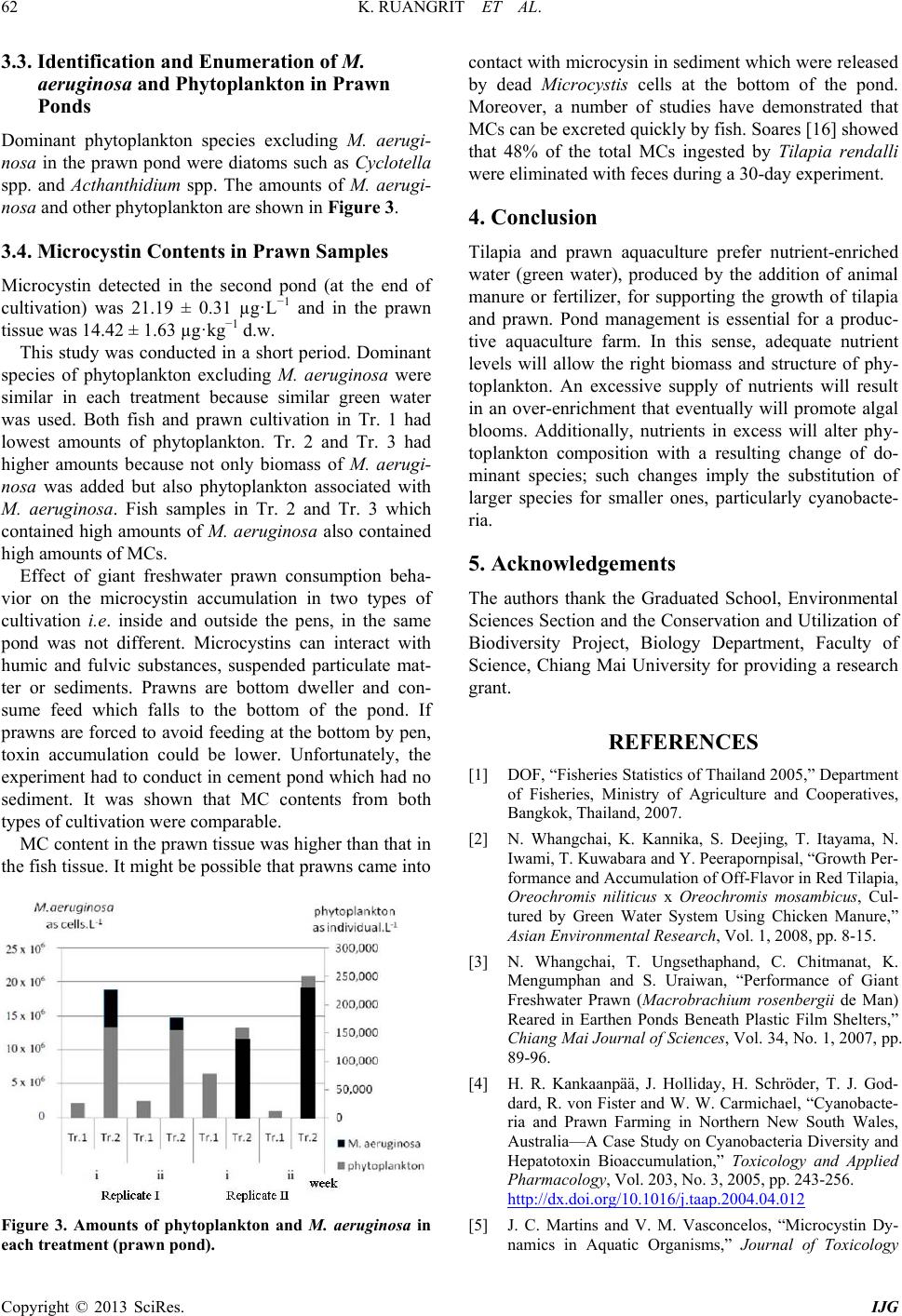
K. RUANGRIT ET AL.
Copyright © 2013 SciRes. IJG
3.3. Identification and Enumeration of M.
aeruginosa and Phytoplankton in Prawn
Ponds
Dominant phytoplankton species excluding M. aerugi-
nosa in the prawn pond were diatoms such as Cyclotella
spp. and Acthanthidium spp. The amounts of M. aerugi-
nosa and other phyto plankton a re s hown in Figure 3.
3.4. Microcystin Contents in Prawn Samples
Microcystin detected in the second pond (at the end of
cultivation) was 21.19 ± 0.31 µg·L−1 and in the prawn
tissue was 14.42 ± 1.63 µg·kg−1 d.w.
This study was conducted in a short period. Dominant
species of phytoplankton excluding M. aeruginosa were
similar in each treatment because similar green water
was used. Both fish and prawn cultivation in Tr. 1 had
lowest amounts of phytoplankton. Tr. 2 and Tr. 3 had
higher amounts because not only biomass of M. aerugi-
nosa was added but also phytoplankton associated with
M. aeruginosa. Fish samples in Tr. 2 and Tr. 3 which
contained high amounts of M. aeruginosa also contained
high amounts of MCs.
Effect of giant freshwater prawn consumption beha-
vior on the microcystin accumulation in two types of
cultivation i.e. inside and outside the pens, in the same
pond was not different. Microcystins can interact with
humic and fulvic substances, suspended particulate mat-
ter or sediments. Prawns are bottom dweller and con-
sume feed which falls to the bottom of the pond. If
prawns are forced to avoid feeding at the bottom by pen,
toxin accumulation could be lower. Unfortunately, the
experiment had to condu ct in cement pond which had no
sediment. It was shown that MC contents from both
types of cultivation were comparable.
MC content in the prawn tissue was higher than that in
the fish tissue. It might be possible that prawns came into
Figure 3. Amounts of phytoplankton and M. aeruginosa in
each treatment (prawn pond).
contact with microcysin in sediment which were released
by dead Microcystis cells at the bottom of the pond.
Moreover, a number of studies have demonstrated that
MCs can be excreted quickly by fish. Soares [16] showed
that 48% of the total MCs ingested by Tilapia rendalli
were eliminated with feces during a 30-day experiment.
4. Conclusion
Tilapia and prawn aquaculture prefer nutrient-enriched
water (green water), produced by the addition of animal
manure or fertilizer, for supporting the growth of tilapia
and prawn. Pond management is essential for a produc-
tive aquaculture farm. In this sense, adequate nutrient
levels will allow the right biomass and structure of phy-
toplankton. An excessive supply of nutrients will result
in an over-enrichment that eventually will promote algal
blooms. Additionally, nutrients in excess will alter phy-
toplankton composition with a resulting change of do-
minant species; such changes imply the substitution of
larger species for smaller ones, particularly cyanobacte-
ria.
5. Acknowledgements
The authors thank the Graduated School, Environmental
Sciences Section and the Conservation and Utilization of
Biodiversity Project, Biology Department, Faculty of
Science, Chiang Mai University for providing a research
grant.
REFERENCES
[1] DOF, “Fisheries Statistics of Thailand 2005,” Department
of Fisheries, Ministry of Agriculture and Cooperatives,
Bangkok, Thailand, 2007.
[2] N. Whangchai, K. Kannika, S. Deejing, T. Itayama, N.
Iwami, T. Kuwabara and Y. Peerapornpisal, “Growth Per-
formance and Accumulation of Of f-Fl avor in Red Tilapia,
Oreochromis niliticus x Oreochromis mosambicus, Cul-
tured by Green Water System Using Chicken Manure,”
Asian Environmental Research, Vol. 1, 2008, pp. 8-15.
[3] N. Whangchai, T. Ungsethaphand, C. Chitmanat, K.
Mengumphan and S. Uraiwan, “Performance of Giant
Freshwater Prawn (Macrobrachium rosenbergii de Man)
Reared in Earthen Ponds Beneath Plastic Film Shelters,”
Chiang Mai Journal of Sciences, Vol. 34, No. 1, 2007, pp.
89-96.
[4] H. R. Kankaanpää, J. Holliday, H. Schröder, T. J. God-
dard, R. von Fister and W. W. Carmichael, “Cyanobacte-
ria and Prawn Farming in Northern New South Wales,
Australia—A Case Study on Cyanoba cteria Di versity and
Hepatotoxin Bioaccumulation,” Toxicology and Applied
Pharmacology, Vol. 203, No. 3, 2005, pp. 243-256.
http://dx.doi.org/10.1016/j.taap.2004.04.012
[5] J. C. Martins and V. M. Vasconcelos, “Microcystin Dy-
namics in Aquatic Organisms,” Journal of Toxicology